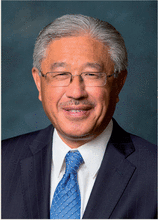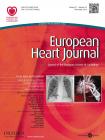-
PDF
- Split View
-
Views
-
Cite
Cite
Victor Dzau MD, European Heart Journal, Volume 37, Issue 34, 7 September 2016, Pages 2618–2619, https://doi.org/10.1093/eurheartj/ehw336
Close - Share Icon Share
Victor Dzau is President of the US National Academy of Medicine—formerly the Institute of Medicine (IOM). He is known for his pioneering work on the renin–angiotensin system (RAS), and for his investigations into gene therapy for vascular disease. His leadership in improving health care delivery has made him a sought-after expert by governments and policy makers around the world.
Born in Shanghai, China, and raised in colonial Hong Kong, Dzau’s early years were shaped by the upheaval and insecurity that followed the end of World War II. The poverty, inequality, and ill health he witnessed growing up propelled him towards medicine. Supported by his family he left Hong Kong, aged 18, to attend McGill University in Canada. At McGill, he was exposed to scientific research for the first time in the laboratory of biochemist Hanna Pappius. Dzau enjoyed the learning environment of Pappius’s laboratory and the willingness to share knowledge that existed there. This early experience taught him to value both good mentorship and good mentors.
After gaining his MD in 1972, Dzau was keen to pursue a career in academic medicine—specifically cardiology—which he thought offered the best chance of being able to understand the physiology behind cardiovascular diseases well enough to treat them. He decided to move to the USA for an internship and eventually found his way to the Peter Bent Brigham Hospital (currently the Brigham & Women’s Hospital) in Boston, MA, one of the teaching hospitals of Harvard University. As one of a group of young residents to come under the insightful and inspiring influence of the ‘father of modern cardiology’, Eugene Braunwald and post-graduate training director Marshall Wolf, Dzau thrived at the Brigham. Braunwald would become a ‘singular influence’ and a lifelong mentor who had already combined the roles of physician, academic, scientist, and administrator, which Dzau would eventually make his own.
As an emerging physician-scientist thinking about a Fellowship topic, Dzau was intrigued by the work of John Laragh of Cornell University into hypertension and RAS in the 1970s. Braunwald advised Dzau to consider working with cardiovascular biochemist Ed Haber and physiologist Cliff Barger—both eminent Harvard professors—who at the time were formulating the question of how to demonstrate that RAS is responsible for hypertension. Dzau joined Haber’s unit as a cardiology fellow at Massachusetts General Hospital (MGH) and started work on the tricky task of purifying renin in order to create antibodies. Dzau relished the opportunity to work in both biochemistry and physiology and his efforts culminated in a paper in Science demonstrating how blood pressure can be lowered by blocking the RAS system. 1
Although Dzau was absorbed in hypertension work at MGH, Braunwald offered him the positon of chief medical resident at the Brigham—a highly unusual role for someone who had not completed their Fellowship. Dzau initially demurred as he was too involved with investigative work, but Braunwald offered to fund a technician to lighten his workload at MGH, and he accepted. He went on to work successfully with a foot in both the Brigham and MGH—a rare occurrence given the rivalry between the two institutions. By his late 20s, Dzau had established a definitive professional profile as a clinician, researcher, administrator, and educator attached to prestigious institutions.
After meeting physiologist Norman Hollenberg at the Brigham and together with Haber, who was at that time synthesizing peptide inhibitors of angiotensin-converting enzymes (ACEs), Dzau became interested in using this new option to treat patients with heart failure. 2 The results were dramatic. Dzau relates the story of an indigent, male Afro-American patient in his 40s who was admitted to the hospital with severe heart failure. He says: ‘It was so bad that he could only sleep by leaning onto the bedside table. We gave him the peptide ACE inhibitor for several days and he improved so dramatically that we transferred him out of ICU and he was soon ready for discharge. As he was clearly without financial support, I asked if he had money for a taxi and he said: ‘Doctor, don’t worry I’ve got plenty of money’, and he reached into his pocket and came out with a roll of dollar bills. When I asked him where he got them from, he said: ‘Oh, I was playing cards with the other patients last night and I won’. We rarely see such dramatic results today, but I tell this story to describe how inspiring it was to translate laboratory findings to the bedside. In spite of initial scepticism this early work helped establish the current understanding of the role of RAS in cardiovascular disease and helped bring about the widespread adoption of ACE inhibitors.

By the mid-1980s Dzau had made a name for himself in hypertension and was being approached with offers of work in the field, but he found his attention was being drawn towards vascular biology and the endothelium. He confided in Braunwald who came up with a radical suggestion in the form of creating a new division called vascular medicine which would bring together clinicians and scientists to look at vascular disease and with Dzau as chief. It struck a chord and Dzau created a group of young enthusiasts from different backgrounds and interests, but a shared vision that vascular biology and vascular disease belong together. His team included Joseph Loscalzo, Gary H. Gibbons, John P. Cooke, Mark Creager, Douglas Vaughn, Jonathan Stamler, and others.
In 1990 Dzau took up the position of as head of cardiology at Stanford University, California—renaming it the Division of Cardiovascular Medicine to reflect what he had learned at Harvard. At Stanford, he embraced the relatively new concept of molecular biology and gene therapy and went on to do pioneering work around vascular disease. Recent work exploring stem cell paracrine mechanisms 3 and the use of microRNA in direct reprogramming of fibroblasts to cardiomyocytes 4 has provided novel insights into stem cell biology and regenerative medicine—an area he is excited about for the future. With no need to enhance his research profile, he continues his investigative work as an expression of passion and creativity and because he says it is too ingrained in his DNA to stop.
Dzau is as well known for his work in public health policy as he is for his clinical and scientific achievements. In 2004, he was appointed Chancellor for Health Affairs at Duke University in North Carolina and president and CEO of the Duke University Health System. A ‘Decade of Dzau’ followed and brought about a major transformation with the creation of multiple new institutes, the wholesale promotion of translational medicine, global health innovation, as well as a revolutionary new electronic medical record system and a supported community care system specific to the needs of local people. He also reached out to groups and health care policy institutions at home and abroad and made Duke an effective and prominent voice in the American health care sphere. 5,6
He is an advocate of physician participation in health policy and says:
It’s our duty as physicians to bring our understanding of health, social inequality and clinical practice to the table to address issues. I always say when I am in Washington that policy makers should understand and have experience of what people are struggling with. It is a missed opportunity when physicians don’t move beyond patient care to change the way the system supports patients and improves healthcare.
Equipping doctors with leadership and business skills, Dzau believes, would empower them to take the lead in consultations and improve the healthcare infrastructure from their unique perspective as clinicians and scientists.
With such a breadth and depth of experience Dzau was an ideal choice for the position of President of the IOM—a role he took on for a 6-year tenure in July 2014. The Institute was no ordinary non-government organization, but was founded as the health arm of the National Academy of Sciences which was established at the behest of US President Abraham Lincoln in 1863 as an independent and objective body to provide advice on important issues to policy makers, health professionals, and the public. It is a demanding role which calls for a multi-skilled, multi-tasker with a keen sense of vision and mission.
Dzau’s first challenge was to oversee the transformation of the IOM into the new National Academy of Medicine. Many were sorry to see the distinguished name of the IOM disappear but Dzau acknowledges a need to move forward and a year into the job is pleased with progress. Dzau laid out his vision for the new Academy in the Journal of the American Medical Association in late 2015. 7 He reaffirmed the Academy would continue to: take up health issues of critical importance; advance science and address medical, social and ethical aspects of scientific advancements in health; and inspire the nation, if not the globe, on grand challenges and ideas.
Dzau’s first project—a commission on a global health risk framework—was bold and timely in the light of recent Ebola and Zika virus outbreaks. The commission’s report, published in January 2016, 8 highlights the need for governments to be prepared for the inevitability of future pandemics and the impact they will have not just on people, but on global security and the economy. The report found severe global underinvestment in preparing for pandemics and highlighted the necessity of more effective long-term planning for emergencies.
Another global issue which the Academy is tackling is the hot topic of human gene editing. In December 2015, the Academy together with the US National Academy of Science, the Chinese Academy of Sciences, and the UK’s Royal Society brought together international scientists, medical and ethics experts in Washington to discuss issues associated with human gene-editing research. The summit was broadly in favour of further research in this revolutionary area of scientific medicine, but stressed the need to act within national and international legal and ethical boundaries. The Academy will to take an active role in fostering further dialogue and develop a study report on the topic as research evolves.
Currently, the Academy is actively identifying a major health-related issue to become the focus of its Grand Challenge in Health and Medicine 2016. Grand Challenge initiatives inspire and unite leaders around the world to tackle major issues and have in the past included space travel and the human genome project. Dzau is not certain what the challenge for 2016 will be, but whatever it is, he is certain to meet it head-on.

References
References are available as supplementary material at European Heart Journal online.



